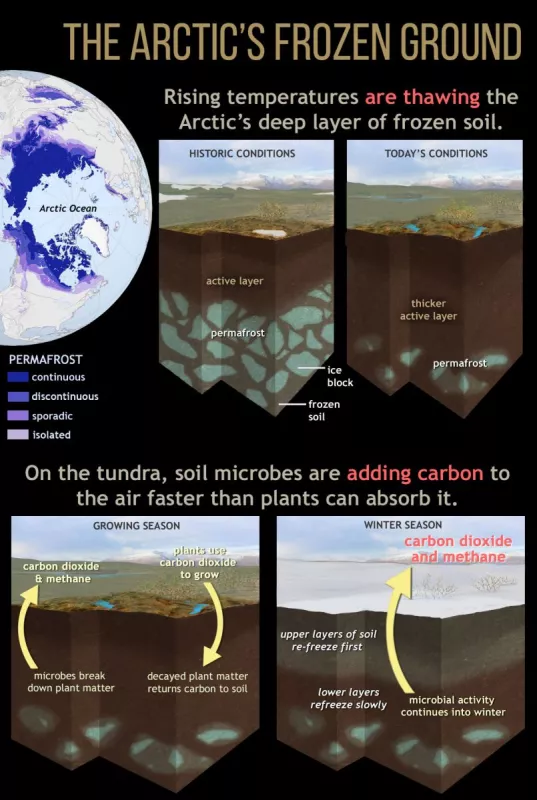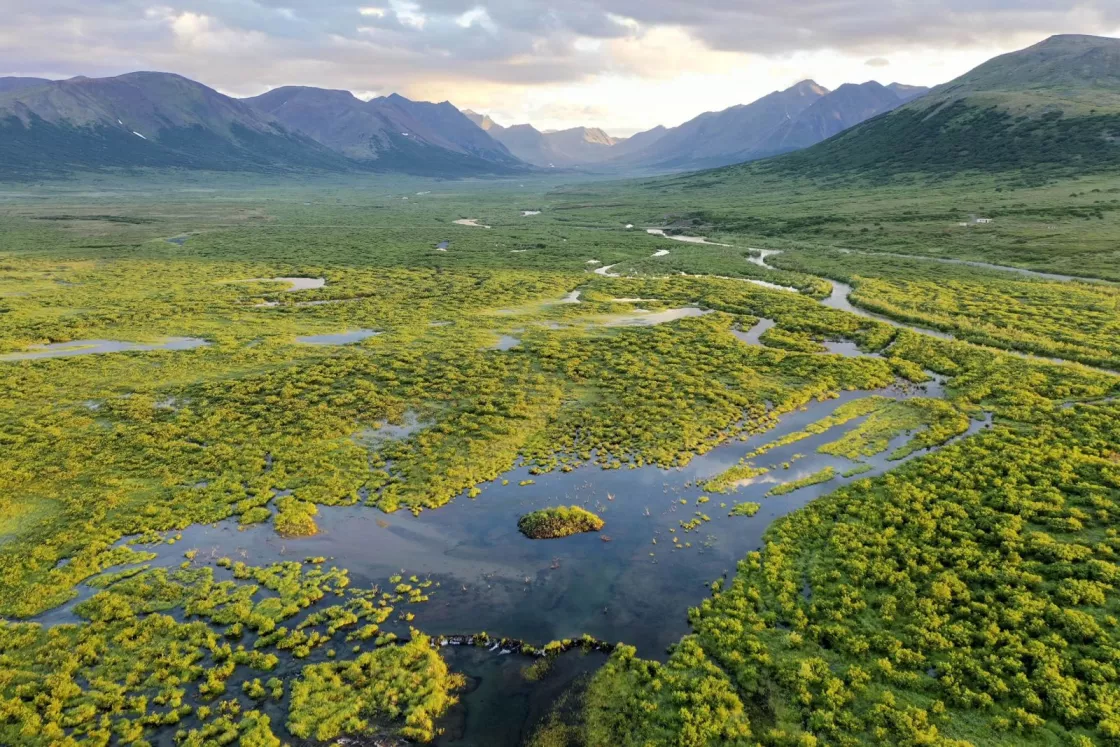On the landmasses surrounding the Arctic Ocean, tundra typically thrives. Tundra landscapes consist of low-profile, cold-adapted plants that eke out their tiny lives in short, cool summers. Since the early 1980s, though, satellites and ground-based studies have detected changes in Arctic vegetation. Shrubs have grown bigger and denser, and their growing season has lengthened slightly. This “greening of the Arctic” raises a question: Will increased plant growth—and the resulting absorption of carbon dioxide—slow climate change?
A greener Arctic, with bigger, longer-living plants, will indeed produce more oxygen and absorb more carbon dioxide—provided more Arctic plants thrive than die off in warmer conditions. But the benefits of increased photosynthesis will likely be overwhelmed by other consequences of a warming Arctic, such as permafrost thaw and landscape-changing invasive species. That kind of Arctic will likely be a net source of carbon rather than a sink.
What the satellites see
Vegetation absorbs light in the portion of the spectrum that is visible to human eyes. At the same time, it strongly reflects near-infrared light. By observing differences in the reflection of visible and near-infrared light, satellite sensors can detect vegetation productivity. Since the early 1980s, satellites have observed an overall increase in tundra vegetation. Though not uniform across the Arctic, the increase in greenness is widespread.
A 2012 study concluded that, at the observed rate of greenness changes, Arctic vegetation could increase by nearly 50 percent by 2050. The study’s lead author, Liang Xu, pointed out that plants would encounter limits to continued expansion, saying, “Unlike temperature, which can increase as greenhouse gases increase, vegetation has hard limits due to the availability of other resources, like solar radiation and precipitation.” The region’s long, dark winters would also limit sunlight crucial for plant growth.
Arctic greening continued in the decade following the 2012 study, according to the Arctic Report Card: Update for 2021 Tundra greenness chapter. Chapter authors noted, however, some localized “browning” events marred the overall greener landscape.
Green or brown?
As warmer conditions and higher levels of carbon dioxide nudge vegetated regions of the Arctic toward greening, those same forces can prompt browning—plant death. Warmer conditions can brown the Arctic in multiple ways.
Many cold-adapted plants “expect” frigid conditions throughout the winter. When temperature spikes occur in winter, the high temperatures lure the plants into budding early, removing their cold resistance. The warmth can also remove the plants’ protective snow covering. When the winter temperatures return to average, the plants are left vulnerable to the cold and less likely to survive until summer.
Dead, dried-out plants, plus a possible increase in lightning strikes, may lead to wildfires, harming more than just the plants that died the previous winter. Meanwhile, permafrost thaw and ground subsidence can produce new bodies of standing water, drowning plants unused to such conditions.
The Arctic Report Card: Update for 2021 noted areas of browning, possibly because of extreme winter warming, or landscape disturbances such as wildfires and standing water. Overall, however, the report indicated that, since satellite observations began in the early 1980s, the five greenest summertime values had all occurred within the previous decade, and that the overall trend was greener.
As the Arctic continues to experience warmer temperatures, though, browning may eventually overwhelm greening. And dead plants do not consume carbon.
Longer growth season, even longer decay season
Another change facing the Arctic is the length of the growing season. Authors of the Arctic Report Card: Update for 2021 Tundra greenness chapter reported that, from 2000 to 2020, the warming climate had led to an earlier arrival of spring (about 2.3 days per decade) and a later arrival of fall (about 1.3 days per decade).
As promising as a longer growing season sounds, a warming Arctic has other consequences that could easily overtake any benefits from increased vegetation density or longevity. The Sun still sinks below the horizon each autumn, and even before it does, falling temperatures shut down plant photosynthesis. Underground, however, warmer conditions have a longer-lasting impact.
Fully assessing the impact of warmer Arctic conditions means considering the effects on permafrost. Permafrost is ground that has stayed at or below the freezing point of water—0°C (32°F)—for at least two years. Warmer conditions in the Arctic lead to permafrost thaw, with its own cascade of effects. As more permafrost heats up, soil microbes decay more plant matter, releasing carbon dioxide and methane in the process. Depending on the amount of permafrost thaw and subterranean warming, microbes can continue breaking down organic matter and releasing greenhouse gases into late autumn or even early winter.
A 2019 study led by NSIDC’s Twila Moon reported that, under a scenario of high fossil-fuel burning, soil carbon emissions will overwhelm increased carbon dioxide uptake by plants by the year 2100.
Unwelcome consequences, uninvited guests
As trees and leafy shrubs start populating the Arctic, many researchers expect the Arctic landscape to start absorbing more heat. Scientists use the term albedo to describe how much heat or light a surface reflects. Xu, lead author of the 2012 tundra study, said, “If the snow is replaced by vegetation, the albedo will change, and it will absorb more solar radiation. A lower albedo will further amplify the warming.”
Lower albedo will not be the only change that begets more change in Arctic tundra. Landscape transformation has already invited new inhabitants.
Leaf-eating moth species may find the Arctic a more welcoming environment. More of their eggs survive warmer winters, and more hungry months eat in the spring and summer, and lay more eggs in the fall. As the Arctic grows shrubbier, mammals native to boreal forests have moved north, such as moose, snowshoe hares, and beavers.
Beavers can be cute. They can also be a problem.
Beavers reengineer the landscape, felling trees to make themselves watery new homes. In a 2018 paper titled “Tundra be dammed,” Ken Tape and coauthors described satellite observations of beaver activity, the results of which are visible from space. They identified 56 new beaver complexes in Alaskan tundra, formed since 1999. In the Arctic Report Card: Update for 2021, Tape and colleagues authored a chapter specifically about beaver engineering. The authors reported satellite mapping of roughly 12,000 beaver ponds in Alaskan tundra, and a rough doubling in the number of beaver ponds over the previous 20 years.
Tape and coauthors noted that research on beavers’ impact on the Arctic remained in its early stages. They also cautioned that the exact cause of the beaver invasion was not known for certain. Hunted to the brink of extinction before the twentieth century, beavers subsequently benefited from trapping restrictions, and their greater numbers likely helped facilitate their migration into Arctic tundra. But warmer conditions, and increased abundance of woody vegetation and liquid water, have probably made the Arctic more inviting to the animals. By felling trees and making themselves ponds, beavers have accelerated the tundra’s transformation. Beaver ponds and connecting waterways thaw the permafrost below. Like all thawing permafrost, soils below beaver ponds can release greenhouse gases.
In short, even though more growing plants in the Arctic will consume more carbon dioxide, they probably will not absorb enough of the greenhouse gas to offset other consequences of warming conditions in the region. A greener Arctic will not necessarily mean a cooler climate.
References
Frost, G.V., M.J. Macander, U.S. Bhatt, L.T. Berner, J.W. Bjerke, H.E. Epstein, B.C. Forbes, S.J. Goetz, M.J. Lara, T. Park, G.K. Phoenix, S.P. Serbin, H. Tømmervik, D.A. Walker, D.Yang. 2021. Tundra greenness. Arctic Report Card: Update for 2021.
Hoag, H. 2019. Climate change made the Arctic greener. Now parts of it are turning brown. ScienceNews.
Moon, T., I. Overeem, M. Druckenmiller, M. Holland, H. Huntington, G. Kling, A.L. Lovecraft, G. Miller, T. Scambos, C. Schädel, E.A.G. Schuur, E. Trochim, F. Wiese, D. Williams, and G. Wong. 2019. The expanding footprint of rapid Arctic change. Earth’s Future 7:212-218. doi.org/10.1029/2018EF001088.
Scott, M., and R. Lindsey. 2021. 2021 Arctic Report Card: Strong greening trend continues across Arctic tundra. NOAA Climate.gov.
Tape, K.D., B.M. Jones, C.D. Arp, I. Nitze, G. Grosse. 2018. Tundra be dammed: Beaver colonization of the Arctic. Global Change Biology 24:4478-4488. https://doi.org/10.1111/gcb.14332.
Tape, K.D., J.A. Clark, B.M. Jones, H.C. Wheeler, P. Marsh, and F. Rosell. 2021. Beaver engineering: Tracking a new disturbance in the Arctic. Arctic Report Card: Update for 2021.
University of Sheffield. 2019. Turning the Arctic brown. EOS.
Xu, L., R. B. Myneni, F. S. Chapin III, T. V. Callaghan, J. E. Pinzon, C. J. Tucker, Z. Zhu, J. Bi, P. Ciais, H. Tommervik, E. S. Euskirchen, B. C. Forbes, S. L. Piao, B. T. Anderson, S. Ganguly, R. R. Nemani, S. J. Goetz, P. S. A. Beck, A. G. Bunn, C. Cao, and J. C. Stroeve. 2013. Temperature and vegetation seasonality diminishment over northern lands. Nature Climate Change, doi:10.1038/nclimate1836.

